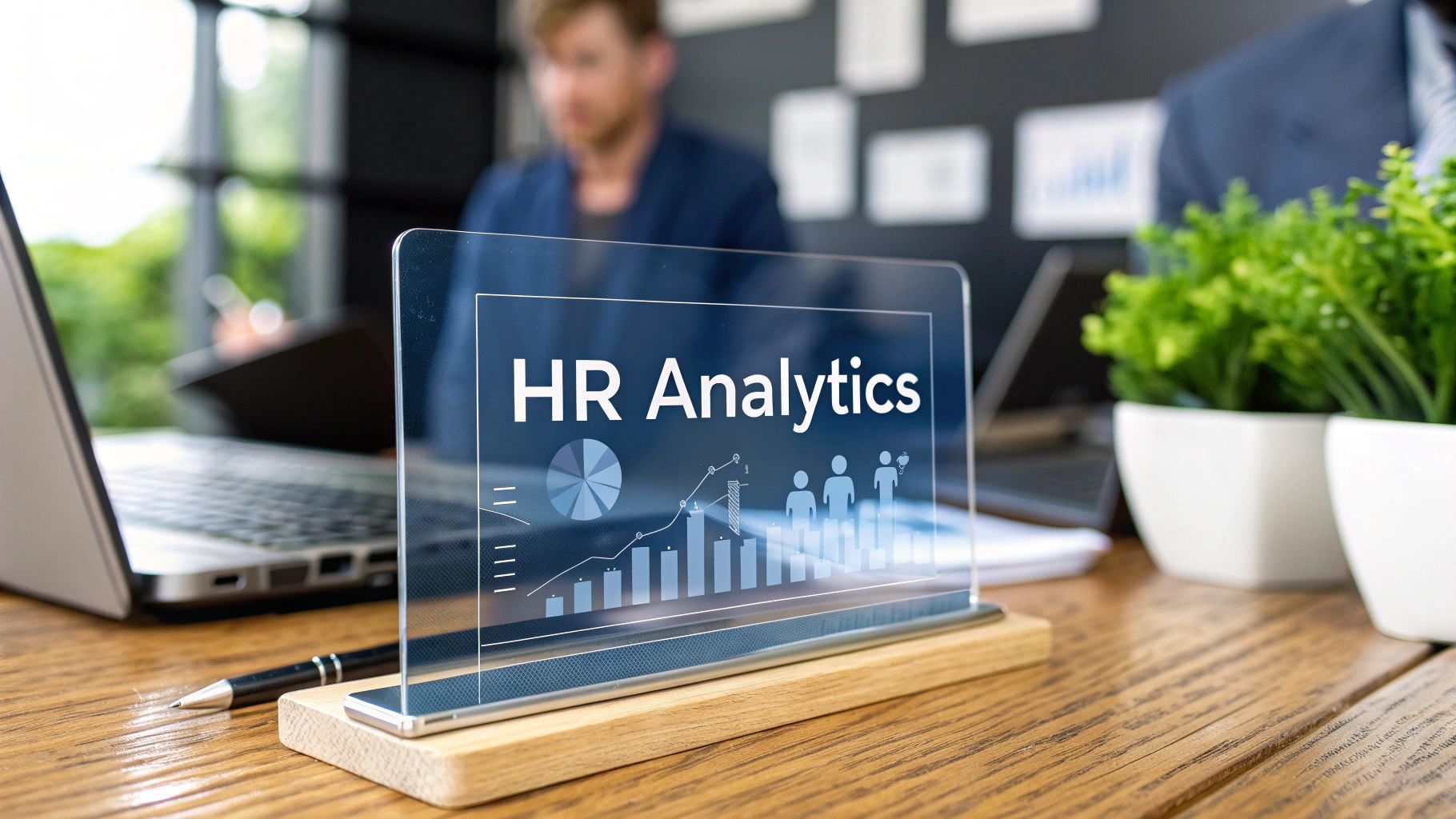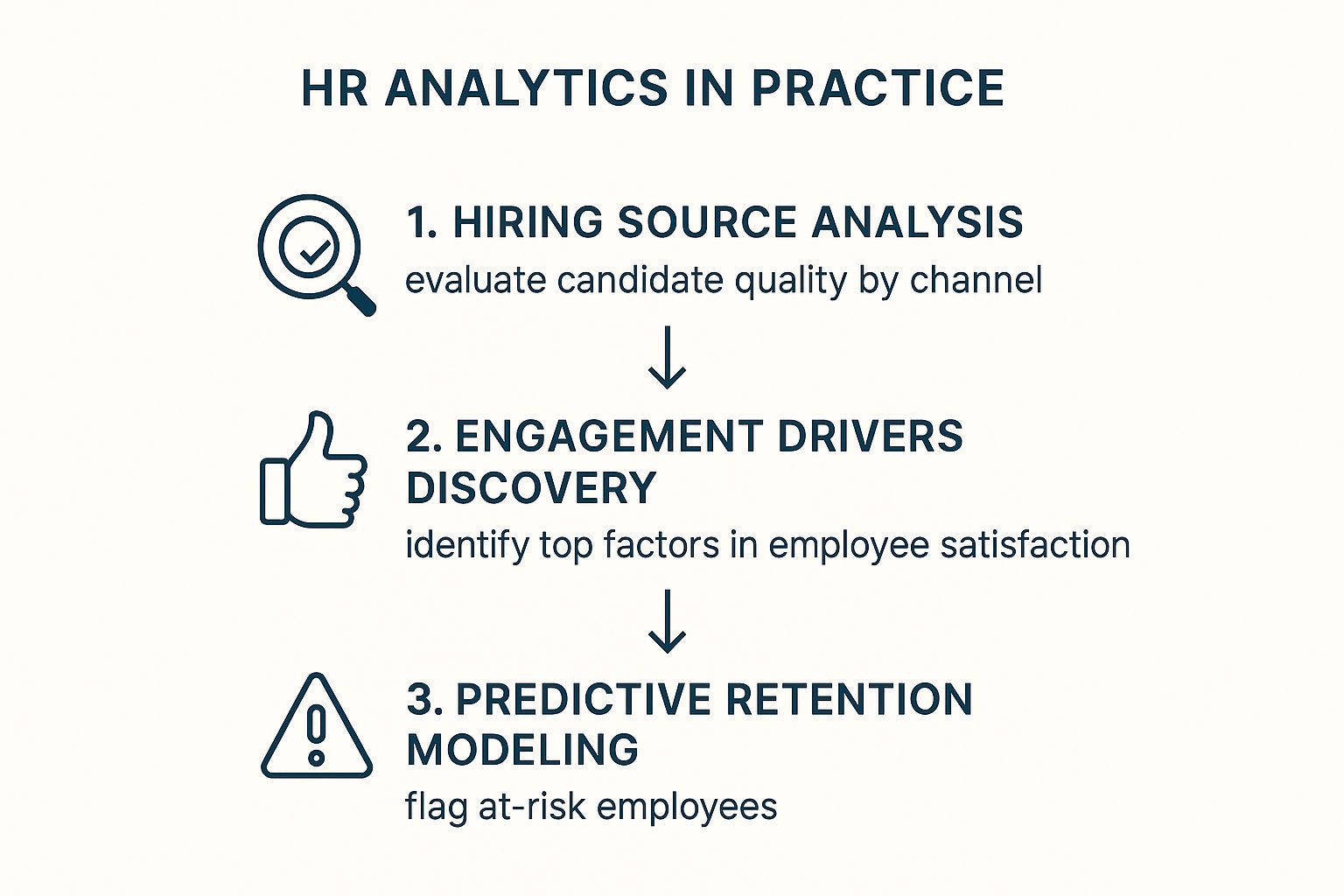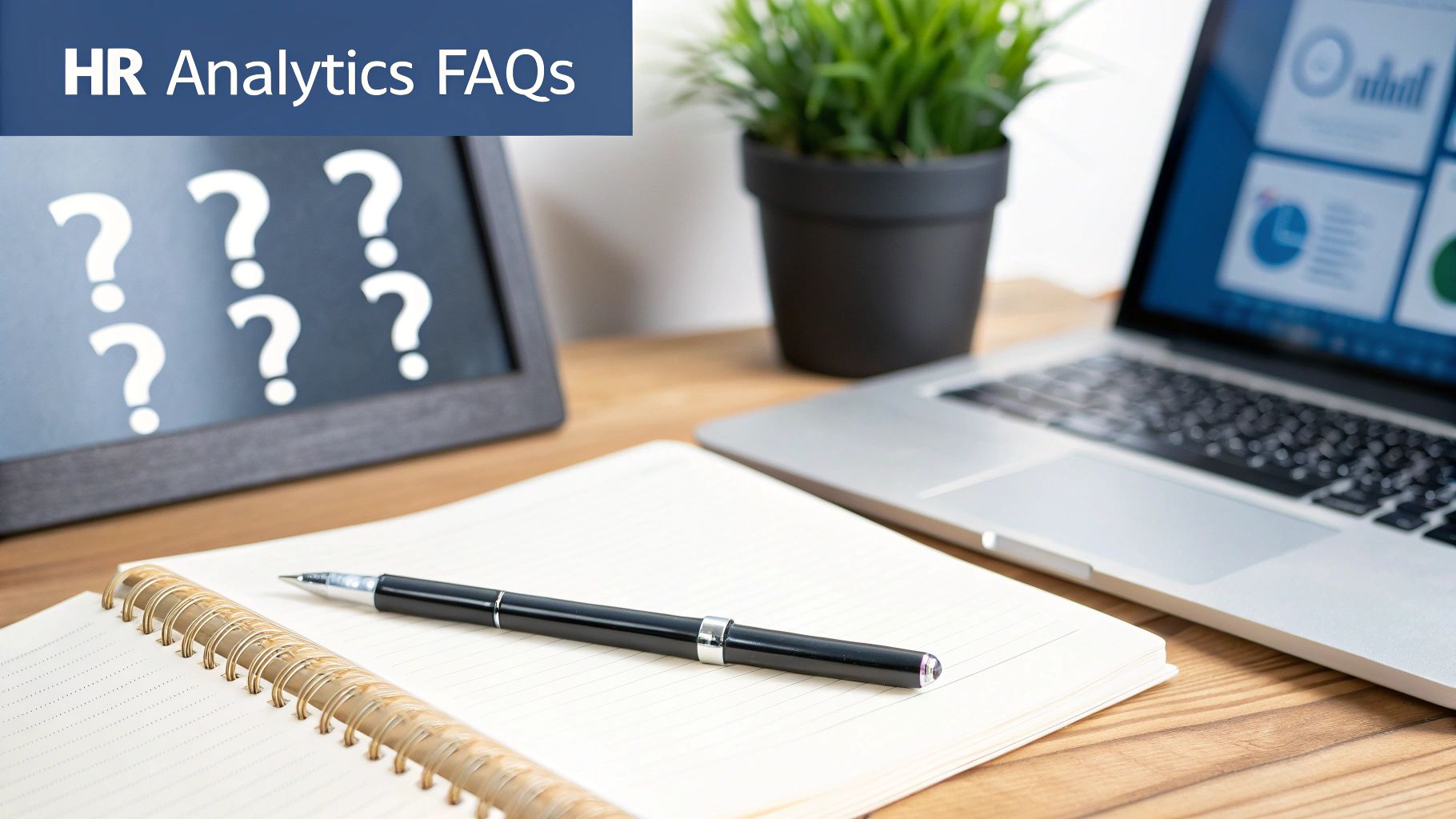
Trying to win a championship without looking at player stats or game footage sounds absurd, right? Yet, for a long time, that’s how many businesses approached their most valuable asset: their people.
Human resource analytics is the antidote to that kind of guesswork. It’s all about turning workforce data into smarter, evidence-based decisions, moving HR from a support function to a genuine strategic powerhouse.
What Is Human Resource Analytics
Human resource analytics, often called people analytics, is the process of collecting, analysing, and reporting on workforce data to improve business outcomes. It swaps gut feelings for clear answers, helping companies understand the real drivers behind things like employee performance, engagement, and retention.
By applying statistical methods to people-related data, you can make informed decisions that boost productivity and profitability.
Instead of wondering which recruitment channels bring in the best candidates, you can analyse the data to find out for sure. Instead of guessing why your top performers are leaving, you can spot patterns in exit interviews and performance reviews. It’s a complete game-changer.
The Strategic Shift In HR
The move towards human resource analytics marks a huge change in how businesses see their workforce. For decades, HR was buried in administrative tasks like payroll and compliance. Today, it’s all about strategic contribution.
- From Reactive to Proactive: Instead of just reacting to problems like high turnover, analytics helps you predict them. This means leaders can put preventative measures in place before top talent walks out the door.
- From Cost Centre to Value Driver: By linking people data directly to business results, HR can finally prove its impact on revenue and growth. For example, showing how a leadership development programme correlates with a 15% increase in team productivity is tangible, undeniable value.
- From Intuition to Evidence: Decisions get backed by data, not just someone’s experience. This helps reduce bias and makes your workforce strategies far more consistent and effective. To really get it, it helps to start with understanding behavioral analytics for corporate training and development.
This chart from Wikipedia does a great job of showing the different levels of people analytics, from basic reporting all the way up to predictive modelling.

As you can see, there's a clear progression. You move from just describing what happened to predicting what will happen—and that’s where the true strategic value is unlocked.
Human Resource Analytics is not about tracking metrics for the sake of it; it's about connecting people-related activities directly to the strategic goals of the organisation.
Here in the Netherlands, for example, there's a growing focus on using analytics to manage talent and improve the employee experience. With only 61% of Dutch employees reported as engaged—which is below the global average—there's a massive opportunity for data to help close that gap and improve satisfaction. Adopting a data-centric mindset has never been more important.
The Strategic Benefits of Using HR Analytics
Adopting HR analytics brings real, tangible advantages that ripple out far beyond the HR department itself. It’s about forging a clear link between your people decisions and the performance of the business, turning abstract goals into results you can actually measure.
The impact usually shows up in three key areas: financial, operational, and strategic.

This data-first approach shifts HR from being seen as a cost centre to becoming a genuine value driver, proving its worth with numbers that are hard to ignore. Let's dig into how that works in the real world.
Driving Financial Performance
The most immediate and obvious benefit of HR analytics is its effect on the bottom line. When you start digging into your workforce data, you can uncover hidden costs and spot opportunities for serious savings.
Take employee turnover, for example. It's incredibly expensive, often costing anywhere from 1.5 to 2 times an employee's annual salary to find and train a replacement. Instead of just shrugging and reporting a high turnover rate, analytics lets you diagnose the root cause. You might find that new hires from a particular recruitment channel are 50% more likely to quit within their first six months.
Armed with that kind of insight, you can stop throwing money at ineffective channels and reallocate your budget to sources that bring in people who stick around. That’s a direct improvement to retention and a direct reduction in hiring costs. This kind of financial clarity makes it much easier to justify HR initiatives and investments.
If you're interested in how to turn raw numbers into smart business moves, our guide on moving from data to decisions is a great next step.
Enhancing Operational Efficiency
Beyond the direct financial wins, human resource analytics makes day-to-day operations run a whole lot smoother. It's all about making sure you have the right people, with the right skills, in the right roles, at precisely the right time. That’s the bedrock of any agile and productive organisation.
By analysing historical project data and employee skill sets, analytics can predict future staffing needs for upcoming projects. This proactive approach prevents costly delays and ensures teams are always optimally staffed.
Think about workforce planning. Instead of constantly reacting to staffing gaps and scrambling to fill roles, you can use predictive models to see what you'll need in the future. Actionable Step: Start by analysing your project pipeline for the next two quarters alongside a current skills inventory of your teams. This allows you to identify potential skill gaps 3-6 months in advance, giving you time to hire or train talent proactively. This drastically reduces your time-to-fill for critical roles and avoids the productivity dips that come with empty seats.
Building Strategic Advantage
Ultimately, the biggest win is strategic. When you take a data-driven approach to managing your people, you can build a more engaged, productive, and resilient workforce. That's not just a nice-to-have; it's a genuine competitive edge.
Effective human resource analytics helps you pinpoint what truly drives employee engagement in your company's unique culture. You might discover that for your tech teams, the number one factor in job satisfaction is access to professional development. For your sales team, it might be the commission structure. This lets you stop guessing and start creating targeted initiatives that actually move the needle on motivation and performance.
The strategic benefits don't stop there. You can also improve:
- Succession Planning: Spot high-potential employees early on and build data-backed development plans to create a strong pipeline of future leaders.
- Diversity and Inclusion: Analyse hiring, promotion, and pay data to uncover and address systemic biases, leading to a fairer and more innovative workplace.
- Talent Management: Figure out which skills and competencies actually correlate with top performance, allowing you to refine your hiring criteria and training programmes.
By aligning your people strategy with your overall business goals, analytics ensures that your most valuable asset—your team—is fully optimised to drive success for the long haul.
Putting HR Analytics into Practice
Theory is great, but action is where human resource analytics really starts to pay off. It’s all about using data to solve the real, everyday problems that pop up across the entire employee journey. By zeroing in on a few specific, high-impact areas, you can get some quick wins and build momentum for a more data-driven HR culture.
This is how HR moves from being a reactive department to a proactive, strategic partner. Instead of guessing, you start making decisions based on solid evidence, directly shaping everything from who you hire to who you keep.
Let's look at a few powerful examples of how this works in the real world.
Optimising Recruitment for Quality Hires
One of the clearest and most immediate ways to use HR analytics is in recruitment. The goal isn’t just to fill seats—it's to consistently bring in top-tier talent who will stick around and do great work. But how do you actually know which hiring sources are delivering the goods?
Instead of going with your gut, you can let the data tell the story. By tracking metrics like 90-day performance ratings, first-year turnover rates, and hiring manager satisfaction scores, you can connect new hires all the way back to where they came from.
- The Problem: You’re spending a ton on different job boards and recruitment agencies, but you’re not sure which ones are actually finding the best long-term employees.
- The Data Needed: Gather data on the source of each hire (e.g., LinkedIn, employee referral, a specific job board), their performance review scores after six months, and whether they're still with the company after a year.
- The Actionable Insight: The analysis might show that while one job board brings in the most applications, employees hired through internal referrals have a 30% higher performance rating and a 50% lower turnover rate in their first year. Actionable Step: Reallocate 25% of your job board budget to increase the employee referral bonus. Promote the referral program internally to drive higher-quality candidates at a lower cost.
Uncovering the Real Drivers of Engagement
Employee engagement is essential for productivity, but those generic annual surveys often don't tell you what truly motivates your people. Human resource analytics helps you dig deeper, getting past surface-level satisfaction scores to find the specific things that build commitment and prevent burnout.
You can combine survey data with other information like absenteeism rates, performance metrics, and even team collaboration patterns to paint a much richer picture. From there, you can start to optimise work patterns with data transparency and build a more supportive environment.
An analysis might reveal that for your engineering teams, the number one predictor of satisfaction is access to professional development. For the sales team, it's a transparent and fair commission structure.
This level of detail lets you create targeted, effective engagement plans instead of one-size-fits-all programmes that fall flat. You can put resources where they’ll make the biggest difference, addressing what different groups in your company actually need.
This infographic shows a typical flow, starting with hiring sources and moving toward proactively managing retention.

As you can see, it’s a logical progression. Insights from hiring help you understand engagement, which then fuels predictive models for keeping your best people.
Predicting and Reducing Employee Turnover
One of the most valuable uses of HR analytics is predictive retention modelling. High employee turnover is incredibly expensive, not just in recruitment costs but in lost knowledge and productivity. Predictive analytics helps you get out in front of the problem.
By analysing historical data from employees who have left, you can build a model that flags the common warning signs.
- Identify Key Factors: The model might find that a mix of things—like a long commute, a recent change in manager, dipping performance scores, and low engagement survey results—is strongly linked to people leaving voluntarily.
- Flag At-Risk Employees: The system can then flag current employees who show a similar pattern of data points, identifying them as being at a higher risk of leaving.
- Enable Proactive Intervention: This gives managers and HR a chance to step in before someone decides to resign. Actionable Step: Create a "retention toolkit" for managers. When an employee is flagged as high-risk, the manager receives a notification with a guide on how to initiate a "stay interview," discussing career goals and addressing potential frustrations before they become reasons to leave.
Your Step-By-Step Implementation Guide
Getting started with human resource analytics can feel like a massive undertaking. But it doesn’t have to be. The trick is to break the process down into manageable steps, so any organisation can start making smarter, data-driven decisions about its people. This isn't about boiling the ocean; it's a practical roadmap designed to build momentum and deliver real value, fast.
The key is to ignore the temptation to get lost in complex data sets. Instead, start with a clear business problem. A focused approach ensures your first project solves a genuine issue and, just as importantly, shows stakeholders the power of what you’re doing.
Step 1: Start With Your Key Business Questions
Before you even think about touching a spreadsheet, you need to know what you’re trying to achieve. The most successful analytics projects don’t begin with data; they begin with a pressing business question. This simple act aligns your efforts with what the organisation actually cares about from day one.
Instead of a vague goal like “improve retention,” get specific. Ask something like, “Why are our top-performing sales representatives in the Amsterdam office leaving within 18 months?” That kind of focus gives your analysis direction and a clear purpose.
Actionable Step: Schedule a 30-minute meeting with a key department head (e.g., Head of Sales, Head of Engineering). Ask them, "What is the biggest people-related challenge keeping you from hitting your goals?" Use their answer to frame your first analytics project.
Step 2: Identify and Gather Your People Data
Once you have your question, the next job is to figure out what data you need to answer it. You probably have a goldmine of information already, but it's likely scattered across different systems. The real challenge is bringing it all together.
For our sales turnover question, you'd likely need to pull a few different threads:
- HRIS Data: Things like hire dates, termination dates, department, manager history, and salary information.
- Performance Data: Quarterly performance review scores and sales goal attainment.
- Engagement Data: Recent employee survey scores or feedback from pulse surveys.
- Exit Interview Data: The reasons people gave for leaving when they walked out the door.
The goal isn’t to gather all the data you have, but the right data you need. Starting with a focused dataset helps you avoid analysis paralysis and find meaningful connections much faster.
Actionable Step: Create a simple data inventory map. In one column, list your business questions. In the next, list the data points needed. In the third, identify the system where that data lives (e.g., HRIS, CRM, SurveyMonkey). This map will become your data collection guide.
Step 3: Select the Right Tools for Your Needs
You don't need a huge budget or a complicated, enterprise-level platform to get started with human resource analytics. Honestly, the best tool is often the one you already have or can adopt with minimal fuss.
- Spreadsheets (Excel/Google Sheets): Perfect for your first few projects. You can easily import data, create pivot tables, and visualise trends to answer basic questions without any extra cost.
- Business Intelligence (BI) Tools (Tableau, Power BI): These step things up with more advanced visuals and dashboarding, letting you create interactive reports that stakeholders can explore themselves.
- Integrated HR Suites (HRIS): Many modern HR systems have built-in analytics dashboards that give you pre-built reports on key metrics like turnover and time-to-hire.
The Dutch labour market is seeing a huge shift towards digital skills and flexible work, which makes having solid analytics even more critical. With a projected rise in flexible and self-employed workers, HR teams need robust tools to make sense of a more diverse workforce. ManpowerGroup reports that 27% of employers plan to hire in Q2 2025, showing just how competitive things are. In this environment, data-driven strategies are essential. You can dig deeper into these trends in this insightful report from PwC on the Dutch labour market.
Step 4: Develop Your Team's Analytical Skills
Technology is only half the equation. Your team's ability to interpret data and ask the right questions is just as important, if not more so. Fostering an analytical mindset within HR is a critical step if you want this to be a long-term success.
This doesn't mean everyone needs to become a data scientist overnight. Focus on building core competencies, like understanding key HR metrics, creating basic data visualisations, and being able to connect what the HR data says to actual business outcomes. Start with small training sessions or even partner with your organisation's finance or BI teams to learn from their expertise. You can also get a deeper understanding of the systems that can help your team with our guide on choosing the right talent management system software.
Step 5: Turn Your Insights into Compelling Stories
This is the final and most crucial step: communicating your findings in a way that makes people want to take action. Raw data and charts rarely persuade senior leaders, but a compelling story always does.
Structure your presentation around a clear narrative:
- The Problem: Kick things off with the business question you set out to answer.
- The Analysis: Briefly explain your method and the key data points you uncovered. No need for a deep dive here.
- The Insight: Present your "aha!" moment—the core finding that came out of your analysis.
- The Recommendation: Propose specific, actionable steps based on what you found.
For example, "Our analysis shows our top sales performers are leaving because they don't see a clear path for career progression. We recommend implementing a formal mentorship programme, which we estimate could improve their retention by 20%." This approach connects your HR analytics work directly to tangible business value, making it impossible to ignore.
How AI Is Shaping the Future of HR
Artificial Intelligence isn't just another tool for crunching numbers; it's fundamentally changing how we approach human resource analytics. We're moving past simple reports that tell us what already happened. AI is giving HR teams predictive powers that, until recently, felt like science fiction.
The shift is creating some incredible opportunities. Instead of just looking at last quarter's turnover rate, AI can now flag high-performing employees who might be at risk of leaving. This lets managers step in with the right support long before that person even starts updating their CV.
From Automation to Augmentation
There's a common myth that AI is coming for HR jobs. The reality is far more interesting and collaborative. AI's real strength isn't in replacing people but in augmenting their skills. It takes on the tedious, data-heavy work, freeing up HR professionals to focus on the things that require a human touch: strategy, empathy, and leadership.
Think of it as the ultimate assistant for your HR team. This assistant can sift through thousands of applications to find the top candidates, spot subtle themes in employee feedback, or identify potential skills gaps across the entire company. This gives the human experts more time to conduct meaningful interviews, design impactful development programmes, and have strategic conversations with business leaders. To see the bigger picture, it's worth exploring the wider role of AI in HR.
Personalising the Employee Experience
One of the most exciting ways AI is being used in HR is in creating a truly personalised experience for every employee. It works a bit like how streaming services learn your tastes and recommend what to watch next. AI can suggest career paths and learning opportunities tailored to an individual’s skills, performance, and personal goals.
This means we can finally move away from generic, one-size-fits-all training. An AI-powered system might notice a skill gap in an employee's latest review and recommend a specific online course to help them close it. This kind of personalised guidance doesn't just speed up professional growth; it makes employees feel seen and invested in.
The future of human resource analytics isn't just about measuring the workforce; it's about understanding and supporting each individual within it. AI provides the tools to achieve this at scale, turning data into truly human-centred actions.
Ethical Considerations and Future-Proofing Skills
Of course, with great power comes great responsibility. Bringing AI into HR means we have to be vigilant about ethics. It's critical to ensure the algorithms used for hiring or promotions are fair, transparent, and free from bias. Organisations have to constantly audit their AI systems to make sure they aren't accidentally amplifying old prejudices.
This tech shift also changes what it means to be an HR professional. According to a recent EY report, 61% of Dutch respondents expect AI to affect their jobs. While 42% worry about being replaced, the real story is about reskilling. As AI automates routine tasks, HR pros will need to lean into strategic thinking and human-centred leadership.
However, the same report found that only 24% are happy with the AI training their employer provides, highlighting a clear skills gap we need to address. Getting teams ready to work alongside AI is the key to unlocking its true potential.
Still Have Questions About HR Analytics?
Even with a clear plan, taking the plunge into human resource analytics can feel a bit daunting. It’s natural to have a few practical questions pop up. Let's tackle some of the most common ones to clear things up and help you move forward with confidence.

This final section gives you straightforward answers, so you can navigate any early hurdles and get your data-driven HR programme off to a strong start.
How Do I Start HR Analytics with a Small Budget?
This is a really common situation, but a tight budget shouldn't stop you. The trick is to start small and prove your worth. Pick one critical business problem where you can already get your hands on the data.
A perfect example is early employee turnover. You likely already have all the data you need: hire dates, termination dates, and notes from exit interviews. It’s all sitting right there in your HR system.
By focusing on a specific, high-impact question like, “Why are our new sales hires leaving within their first year?”, you create a low-cost project that delivers immediate, visible value. That initial success is what builds a powerful case for getting a bigger budget for more advanced tools down the road.
The best way to secure more investment for HR analytics is to show a clear return on investment from a small, well-defined first project.
What Are the Most Important HR Metrics to Track?
Honestly, the "best" metrics are always the ones that tie directly into what your organisation is trying to achieve. That said, there's a solid set of foundational metrics that gives almost any business a great starting point.
- Time to Hire: How efficient is your recruitment process, from the day a job opens to the day an offer is accepted?
- Cost per Hire: This tracks the total investment it takes to bring on a new employee. It’s essential for optimising your recruitment spend.
- Employee Turnover Rate: A vital sign of your workforce’s stability and a good gauge of employee satisfaction.
- Engagement Score: This gives you a snapshot of morale, motivation, and how committed your people feel.
The real magic happens when you connect these dots to bigger business outcomes. For example, if you can show how a lower turnover rate in your customer service team directly correlates with higher customer satisfaction scores, that’s data the C-suite can’t ignore.
Do I Need to Hire a Data Scientist for My HR Team?
Not right away, especially when you're just getting started. Many modern HR platforms come with built-in analytics dashboards that do a lot of the heavy lifting for you, making the data much easier to understand.
Your first priority should be to build analytical thinking within your existing HR team. Train them to ask the right questions and interpret the results correctly. For anything more complex, you can often collaborate with your company's finance or business intelligence teams long before you need to think about hiring a dedicated HR data scientist.
At WhatPulse, we believe that understanding how work actually happens is the key to unlocking productivity and efficiency. Our privacy-first analytics platform gives you the real-world data you need to make smarter decisions about software adoption, resource allocation, and team focus—all while maintaining employee trust. Turn your usage data into actionable insights by visiting https://whatpulse.pro.
Start a free trial